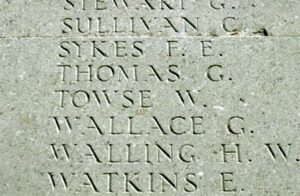In a small Hamlet, bordering the towns of Laugharne and St. Clears, sits Bwlchnewydd Chapel. This Chapel catered for the religious needs of the local Methodist population, being built in 1802, it was renovated and then re-opened in 1953 by its eldest member, my Great, Great Grandmother, Mrs. Eliza John, whose two sons died during the Great War. Her sons, along with four other members of the congregation who fell, are commemorated on a white marble war memorial within the Chapel.
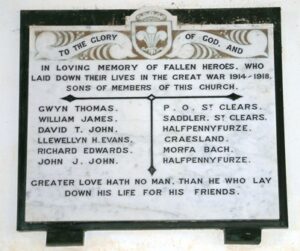
Memorial Service
Combined with the anniversary services of the Bwlchnewydd Baptist Church on Sunday and Monday was a most impressive memorial service on Sunday afternoon to the fallen heroes in the Great War connected with that church and congregation. The special preacher for the anniversary services was the Rev Waldo Roberts, chaplain to H.M. Forces, and future minister of Skewen B. Church. The rev. gentleman had seen much service in Egypt, where he did excellent work and was very popular with the men of all ranks. Hi sermons on Sunday and Monday last were highly appreciated by large congregations. The memorial service in the afternoon took the form of the unveiling of a beautiful tablet finely executed by Mr, Owen Williams and Bros., sculptors, Laugharne, and bore the inscription:
“To the Glory of God and in loving memory of he following heroes of the great war 1914-1918:- Gwyn Thomas, Post Office, St. Clears; William James, Saddler, St. Clears; David Thomas John, Halfpenny Furze, Laugharne; Llewellyn Humphrey Evans, Craesland, Laugharne; Richard Edwards, Morfa Bach, Laugharne; John James John, Halfpenny Furze, Laugharne. “Greater love hath no man than gave his life for his friends.”
The pastor, Rev. J. R. Phillips, on behalf of the Church, performed the unveiling, and in doing so impressively referred to the sacrifice of the boys that they were commemorating that day, a sacrifice which we of the present day did not fully realise. Future historians would reveal the true greatness of that sacrifice. “For ever with the Lord” having been sung, Rev. Waldo Roberts preached an appropriate English sermon, basing his remarks on Romans xii. The collections during the services amounted to £40.
The Great War, 1914-1918
Richard Edwards, Private, 56935, Welsh Regiment. Richard was born at Morfa Bach Cottage, Laugharne, the son of David Edwards, a railway platelayer, and Lizzie Edwards (nee John). Richard joined the Pembroke Yeomanry, and probably trained at Brecon before transferring to the 13th (Service) Battalion (2nd Rhondda) the Welsh Regiment, his service number changing to 56935. The 13th Welsh had been raised in Cardiff on 23 October 1914, becoming part of 129 Brigade, 43rd Division at Rhyl. On 2 December 1915 they landed at Havre, by then the formation having become 114 Brigade, 38th (Welsh) Division. Richard joined up with the 13th Welsh after it had taken part in the assault on Mametz Wood. He joined up with the battalion at Ypres on 11 August 1916, and fought with it through the Battle of Pilckem Ridge the following year. Through the winter of 1917/18, the 38th Division remained at Armentieres, and in April 1918 was moved to the Somme, where it took the line at Aveluy Wood. The first moves for the Welshmen were to straighten the line here, and in the coming days, small attacks were carried out to enable this. According to the Battalion War Diary for the days leading up to Richard’s death, on 22 April 1918, the Battalion attacked ‘on a 2 brigade frontage to left of battalion front. Our artillery both in the initial stages and in the subsequent harassing and protective fire, fired consistently short. Enemy barrage lines not heavy but most clearly defined. About 60-80 prisoners were captured, our casualties being considerable.’ The entry for 23 April states- ‘In connection with yesterdays operations, No. 11 Platoon under Lt. Col. Barry was sent to reinforce 2nd RWF on our left who in turn reinforced 113 Brigade. Bttn sent out 2 patrols in the early morning. 1 Prisoner being brought in. Enemy aircraft active at dawn. At about 2.45 pm a hostile aeroplane crashed just behind our front line. At 7.30 pm, enemy fired a counter preparation programme lasting about 35 min. He kept up a harassing fire all night. Advance parties from 19th Bttn. AIF reconnoitred the line during the night with a view to relief.’ On the 24th the entry states- ‘No Mans Land was patrolled by us in the early morning at about 4.30 am. The enemy attempted to attacks to regain ground lost on night 22-23rd. The first was repulsed by artillery and infantry fire, the second by LG and MG fire. The valley and embankment in which Bttn HQ was situated was shelled intermittently from dusk to midnight. A total of about 20 casualties, chiefly Police & runners were caused. Both artilleries active all day& during the night with harassing fire on the roadside. Visibility poor, aerial activity nil.’ Richard was killed in action on 24 April 1918, aged 28. He is buried in Contay British Cemetery, near Albert on the Somme.
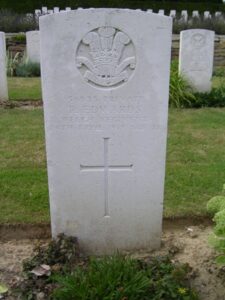
Llewellyn Humphreys Evans, Private, 25830, Lancashire Fusiliers. Llewellyn was born in 1893, the son of James and Eliza Evans, of Graesland Farm, Laugharne. Llewellyn enlisted at Carmarthen into the Army, and was posted into the 15th (Service) Battalion (Salford Pals), the Lancashire Fusiliers. The 15th Battalion were raised in Salford on 11 September 1914, moving to Conway on 28 December 1914. From there they moved to Catterick to join 96 Brigade, 32nd Division on 21 June 1915. They landed at Boulogne on 22 November 1915, and remained on the Western Front. The Battalion fought on the opening day of the Battle of the Somme, 1 July 1916, but were virtually annihilated during that day. Over the coming weeks, the battalion was reinforced, and moved back into the line at Beaumont Hamel, in support of the 19th Division. Llewellyn was killed in action here on 26 November 1916, during the action around Beaumont Hamel (which the 51st (Highland) Division famously captured during November 1916). The Battalion War Diary entry for the period doesn’t mention their involvement in any actions, but the Battalion had just left Munich Trench at Beaumont Hamel-which was on the Front Lines of the Somme battlefield. Llewellyn was 23 years old, and is buried at Mailly Wood Cemetery, near Albert on the Somme, in grave II.C.8.
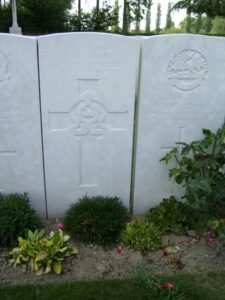
William James, Sapper, 763, Royal Engineers. William was born at St. Clears, the son of Evan and Phoebe James, of The Three Bells. He enlisted at Carmarthen into the 1/1st Welsh Field Company, Royal Engineers, which formed part of the 53rd (Welsh) Division. The Division was a formation created by the establishment of the Territorial Force in 1908. Several of the Divisions units left between November 1914 and February 1915 to act as reinforcements to Divisions already in the field. These were gradually replaced by Second-Line units. In November 1914, an order for the Division to proceed to India was eventually cancelled; the plans for their future had been changed. The 53rd (Welsh) Division was to move to the Mediterranean, and sailed from Devonport in July 1915 arriving at Mudros by 5 August 1915. From here they moved to Gallipoli, landing on 9 August at Suvla Bay. They were at Cape Helles during September, where the Royal Engineers were kept busy, building shelters, and digging wells, and it was at Helles that William was killed in Action on 5 September 1915, aged 35. He is buried at Green Hill Cemetery, Gallipoli.
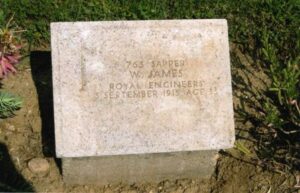
David Thomas John, Lance Corporal, 244, Australian Imperial Force. David was born on 2 July 1891, the eldest son of William and Elizabeth John, of Halfpenny Furze, Laugharne. In 1913, David married Lillian Evans of Laugharne, and they had a son, John William John, who would become my Grandfather. At the outbreak of war, David was working as a Coalminer, in Bulli, New South Wales, Australia. On 18 August 1914, he enlisted at Randwick, NSW into ‘A’ Company, 4th Battalion, Australian Imperial Force. During April 1915, David embarked on the Troopship Lake Michigan, bound for Alexandria from Australia. The ship arrived on 5 April 1915, and the troops were sent to Gallipoli. On 29 July 1915, David was temporarily transferred to duties with Brigade Engineers as a well sinker, but by 24 August 1915, David was suffering badly with fever, and was admitted to a Casualty Clearing Station, diagnosed with Pyrexia. By 28 August, David was diagnosed with Debility, and was transferred to No.3 Auxiliary Hospital and from there sent back to hospital at Alexandria. By 20 November 1915, David was deemed fit enough for duty, and was transferred back to Base at Cairo, finally rejoining his Battalion on 2 January 1916. By 12 February he was back in Hospital in Egypt and suffered spells in and out of the sick bed for some weeks. On 29 March 1916, the Battalion boarded the troopship Transylvania and embarked from Alexandria to join the BEF in France, landing at Marseilles on 6 April 1916. After a quiet period of trench initiation in the Fleurbaix Sector, the Australians were moved to the Somme, being billeted around Warloy Baillon. The Australians were sent into action on 23 July 1916, tasked with the capture of the strongly defended Pozières Ridge. The village of Pozières was taken by the Australians at a huge cost in lives and remains one of the greatest feats of arms of WW1. After taking Pozières, the front that the Australians now occupied was facing the renowned German Stronghold of Mouquet Farm. This was an immensely formidable fortified farmhouse, with a complex of bunkers and trenches. David’s Service papers show that on 11 August 1916 he was promoted to Lance Corporal, and that day his Battalion was sent back to the front line, directly opposite Mouquet Farm. On 18 August 1916, the 4th Battalion were entrenched near Mouquet Farm, poised to make an assault on its defences. Company Headquarters were about 100 yards away from the Front Line trenches, and HQ wanted a patrol sent out to reconnoitre the area, as they were going to launch an assault later that afternoon. David and three other men stepped forward; Private Oliver Williams, Private Bernard Conaty and Private Green. At 2 pm the four men went out of the trench and crossed through the barbed wire defences of the German Front Line, where a German Patrol surprised them. They were shot at and shelled from the German Lines and managed to return some fire and bombs themselves, but only Privates Conaty and Green escaped to tell the tale. David and Oliver Williams had been killed in an area known as Shrapnel Gully, or Point 55, which is now a sedate looking field near to the rebuilt farmhouse. David’s body was never recovered and he is remembered on the Australian National Memorial at Villers-Brettoneux. He was 25 years old and had left a 3-year-old son behind (my paternal Grandfather).
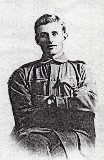
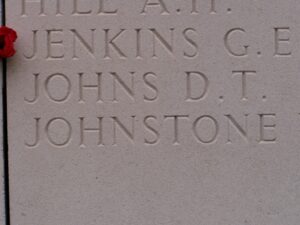
John James John, Private, 320374, Welsh Regiment. John was born on 21 May 1895 at Pontygwaith, Tyler’s Town, the fourth child of William and Eliza John. The family later returned to their native Laugharne, and lived at Halfpenny Furze. John had worked as a miner at Tylorstown before returning to work as a farm hand at Llansteffan prior to the war. He enlisted into the Pembroke Yeomanry in 1915, with the service number 4837. The Pembroke Yeomanry moved to Egypt early in 1916, and after a year on the Suez Canal defences, merged with the Glamorgan Yeomanry to form the 24th Battalion, Welsh Regiment. John’s service number then changed to 320374. The 24th Welsh was a Territorial Battalion, and was attached to 231 Brigade, 74th Division. After a difficult campaign in Palestine, during May 1918 the 24th Welsh was sent to France, landing at Marseilles on 7 May 1918. They fought on the Lys, before moving south to take part in the push across the old Somme battlefields towards the Hindenburg Line. John was killed in action during the attack on Gillemont Farm, part of the outer defences for the Hindenburg Line, on 21 September 1918. He was 25 years old, and is buried at Unicorn Cemetery, Vendhuile, Aisne, France. Casualties suffered by the Battalion during that attack were two officers and twelve other ranks killed, four officers and ninety-two other ranks wounded. The missing totalled one officer and twenty-three other ranks. The battalion war diary for the attack states; ‘Owing to heavy counter attack against brigade on right and division on left not gaining objectives, 231 Brigade had to withdraw at night to Benjamin Trench and later brigade were relieved by 230 Brigade. Became reserve- the battalion withdrawing to Hussar Road.’
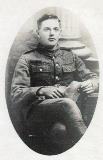
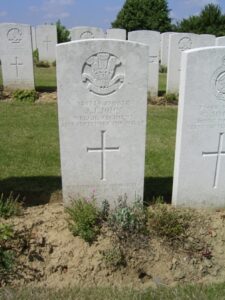
Brythonfryn Gwyn Thomas, Private, 1972, Royal Army Medical Corps. Gwyn was born at St. Clears, the son of John and Mary Jane Thomas, of the Blue Boar Public House. He enlisted at Swansea into the 1/3rd Welsh Field Ambulance, Royal Army Medical Corps. The 1/3rd Field Ambulance served with the 53rd (Welsh) Division, and landed at Suvla Bay on 6 August 1915, where they set up their stations. These men of the Field Ambulance were soon to be sorely tested. Over the coming days, they became swamped with hundreds, if not thousands, of casualties from the first days fighting during the Battle of Sari Bair. Conditions must have been dreadful, as the battlefields were already sown with the dead of previous assaults, and the bloated corpses in No Man’s Land played host to millions of flies, which infested everywhere, sowing their germs and diseases, adding to the misery of the men on the peninsula. Sadly Gwyn was wounded during this terrible time, and he was evacuated off the Peninsula, onto a Hospital Ship moored in Suvla Bay. Gwyn died of wounds on-board the Hospital Ship on 15 August 1915, aged 23. He was buried at sea, and so he is remembered on the Helles Memorial, Gallipoli.

